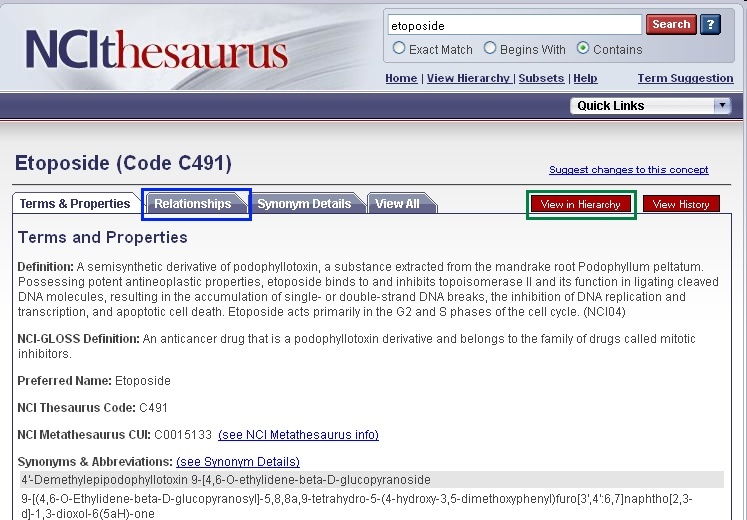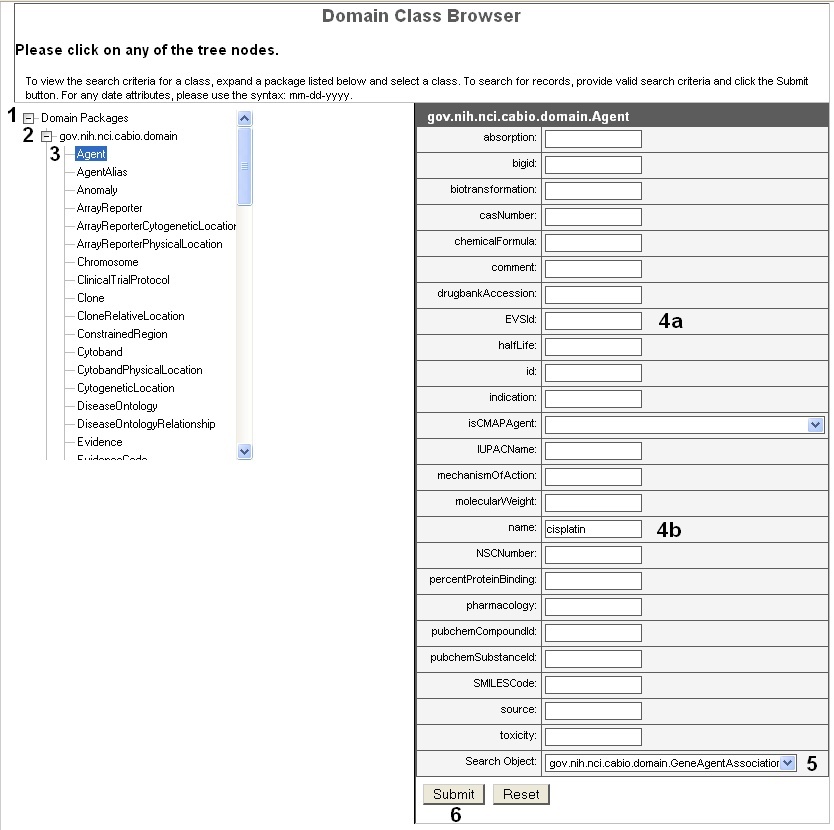To Print the Guide
We recommend you print one wiki page of the guide at a time. To do this, click the printer icon at the top right of the page; then from the browser File menu, choose Print. Printing multiple pages at one time is more complex. For instructions, refer to How do I print multiple pages?.
Overview
The caBIO Portal Search for Biological Entities tool is useful for querying a specific type of object to identify those with attributes that are associated with your compound search term. This tool may be useful if you want to view only specific types of objects related to Cancer Gene Index.
Identifying a Disease Search Term
In order to search for genes that are associated with a given compound, you must first have either an NCI Thesaurus term or concept code for the compound of interest. To find both of these values, navigate to the NCI Thesaurus web page. Select the Contains radio button so that the search will return any terms that contain your keywords (1). Enter your keyword/s (2), and click the Search button (3). If you cannot find the term for which you were looking, click on the Contact Us link at the bottom of the web page (4).
Search Tip
You may use the question mark wild card character after your search term (e.g., "etoposide?") if you choose to use Exact Match or {{Begins With}.
Note
Although the Cancer Gene Index refers to pharmacological substances as "compounds" or "drugs," the NCI Thesaurus uses the term "agent."
Select the desired result from the list of retrieved thesaurus terms in order to view the term's concept page. You may use either the Preferred Term (1) or the Thesaurus Code (2) with the Search for Biological Entities tool.
Tip
The NCI Thesaurus Code and the EVS Identifier are identical.
If you would like to uncover compound ontologies in order to query the Search Biological Entities functionality for parent and child concepts as well, you may find the names and NCI Thesaurus Codes for the immediate parent or child concepts by clicking on the Relationships tab (blue box). Alternatively, you may view parent, sister, and child concepts by clicking View in Hierarchy (green box).
Using the Search for Biological Entities tool
To search for genes that are associated with a particular compound, in the Domain Packages tree (1) expand the gov.nih.nci.cabio.domain package tree node (2) and select Agent class (3). In the gov.nih.nci.cabio.domain.Agent search form, provide the compound term NCI Thesaurus concept code in the EVSid field (4a) or the NCI Thesaurus term name in the name field (4b). Select the gov.nih.nci.cabio.domain.GeneAgentAssociation from the Search Object drop-down list (5), and click the Submit button (6).
Retrieved results are listed as records in a single table (top panel), which includes each object's identifier, the Role Code and/or Role Detail associated with the gene-compound concept pair, notation that the data derive from the Cancer Gene Index, and three method links - getGene, getEvidenceCollection, and getAgent. To view the gene-compound sentence and annotation information, select the getEvidenceCollection method (green box in top panel) to call up the associated Evidence type object (green box in middle panel).
Search Tip
If you do not want to spend time navigating through the caBIO object model for candidate gene-compound associations that were found to be false positives, unclear, or redundant to other data, you should first view the Evidence objects. Scroll to the right to check that the sentenceStatus is finished and negationIndicator is no before clicking through to gene name information in the Gene object.
Click on the getGene method link of any record (blue box in top panel) to access the related Gene object, which contains the full name and HUGO Gene Symbol in the fullName and hugoSymbol columns for the gene associated with the evidence (blue box in middle panel).



